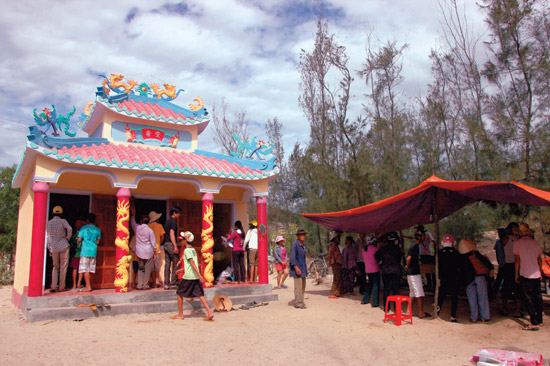(No.2, Vol.2 Feb 2012 Vietnam Heritage Magazine)

A whale shrine at Tam Tien Commune, Nui Thanh District, Quang Nam Province.

At a whale-worship festival in Tam Hai Commune, Nui Thanh District, Quang Nam Province, in 2010.

At a whale-worship festival in Tam Hai Commune, Nui Thanh District, Quang Nam Province, in 2010.
Vietnamese fishermen, especially those of southern Central Vietnam, respect and are grateful to the whale, which they call ‘Ông’, ‘Mr’. They say the whale is a transformation of the frock of an Avalokitesvara bodhisattva, which was thrown into the sea as a lifesaver.
According to the book Popular Literature of Quang Nam, by Nguyen Van Bon, published by the Department of Culture and Information in Quang Nam in 2001, there is a tale that, chased by the Tay Son army, the naval force of Nguyen Anh, on boats drifting when a storm started to blow violently, and now going to sink, were helped to shore by a big whale.
Later, when he had defeated the Tay Son army and become king, in 1802, Nguyen Anh conferred the title of Great General of the South Sea on the whale and called upon the local people to build a temple to worship it. [The word ‘tale’ in this paragraph is used advisedly, as, although the related events are recent, it is not known whether they are fact or not. Vietnam Heritage has checked and found no source saying the events are historical. They are a story many people in many places across Vietnam believe. It is common for even 19th- and 20th-century events in Vietnam to go undocumented and be communicated village-style, as stories.]
During my field trips to study the culture of fishermen on the coast of Quang Nam, they said that when a whale died they held a funeral. Whoever discovered the body had to go in mourning to the dead whale as he would to his father as the eldest son and call the whale Ông Sanh – the one that gives him a second birth into this life. Fishermen considered it lucky to have a dead whale drift to their village. The place where a whale died was sacred and lucky.
According to the book Customs-Habits-Festivals, Quang Nam, published by the Department of Culture and Information in Quang Nam in 2004, in feudal times when a whale died the court provided the villagers nearby with money required for a burial with candles, incense sticks and red shrouding. Land was granted for a mausoleum and temple.
The title conferred on the whale depended on villagers’ suggestions and what kind of services the whale had done for the people.

A dead whale and its coffin in Tam Tien Commune, Nui Thanh District, Quang Nam Province, in June, 2011. The sign announces the whale as a deity of the Eastern Sea.
Photos: Tran Tan Vinh

A dead whale and its coffin in Tam Tien Commune, Nui Thanh District, Quang Nam Province, in June, 2011. The sign announces the whale as a deity of the Eastern Sea.
Photos: Tran Tan Vinh
In recent decades, the number of dead whales on the coastal areas in Qu?ng Nam Province in south central Vietnam has greatly increased, especially along the shore of Núi Thành District. Old fishermen say it is because this area is given preferential treatment by nature, with blue water, calm seas and fine sand, which would attract drifting dead whales.
According to Customs-Habits-Festivals, Quang Nam, in the minds of fishermen the whale is not only the saving god of the sea but determiner of the fates of fishing villages.
When a dead whale is found, the fishermen move their boat gently up to the body, get it to shore, find a high, clean place overlooking the sea for burial and conduct a funeral lasting three days. A festival is held, with worship, singing of the deeds of the whale and a boat race.

Photo: Tran Tan Vinh
Pictures: A whale cemetery in Tam Hai
Commune, Nui Thanh District, Quang Nam Province, and a gravestone of a whale named Ông Chuông (Mr Chuông) in Tam Giang
Commune, Nui Thanh District, Quang Nam Province
Ceremonies are held three, seven, 49, 90 and 100 days after burial, as for a person.
Fishermen bring offerings and contributed money to the funeral.
Every year during the spring festival and autumn festival, fishermen from near and far worship the whale.
I met Mr Phan Van Chuong, born in 1960, resident of the hamlet No 1, Tam Giang Commune, Núi Thành District, Qu?ng Nam Province, who participated in the burial of and funeral for a whale in 2004. He told me that on 14 September, 2004, a whale weighing about 5 tonnes and about 12 metres long had drifted to the Tam Giang shore. Fishermen had piloted the dead whale into the Tr??ng Giang River and people from An H?i fishing hamlet, Tam Giang Commune, had dug a canal from the Tr??ng Giang River to the burial site that had been chosen in the R?ng Mi?u, Tam Giang Commune.
On the morning of the burial, hundreds of villagers of An H?i, in clean, neat clothes, came together at the riverside where the body of the whale was. An altar had been set up. The funeral master conducted a ceremony of gratitude. The young people used a rope to pull the whale into the R?ng Mi?u. The body, washed and wrapped in seven layers of red cloth, was lowered into a grave lined with joss-papers, to drum, trumpet and gong.n
*Mai Hong Lam works at Quang Nam Museum and has participated in some archaeological and cultural study projects on Quang Nam Province and the coast further south.

